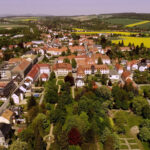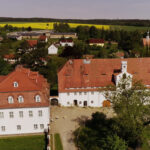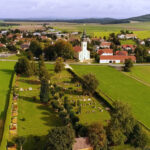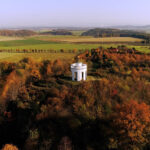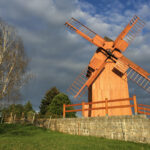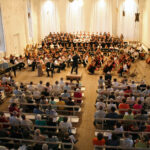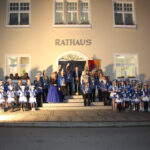Herrnhut, Saxony, Germany
The municipality Herrnhut with its almost 6000 inhabitants spread across 12 villages is located in the Saxon county Görlitz in Upper Lusatia, centrally positioned between Löbau and Zittau. Dresden is around 70 kilometers away. The village was founded in 1722 when religious refugees from Bohemia and Moravia were allowed to settle on the Berthelsdorf estate. Herrnhut was and remains the headquarters of the Moravian Church, an Evangelic unity counting 1.2 million members across 30 countries.
Various institutions of the church remain central to municipal life today: a prime example is the visitor’s center of the Herrnhuter Star Manufactory, which welcomes up to 70000 visitors every year. Daily life is characterized by the foundation, the Evangelic schools, the church archive, the heritage museum (which originated from collections of the church and is now part of the Dresden State Art Collection) and the prayer room, which serves not only as a religious space, but also as a socio-cultural hotspot for the public.
Compared to 1990, the population has shrunk by one quarter. However, the number of middle-sized enterprises in trade, sales, industry and services has doubled since 2007, available jobs increased by 15 percent. The municipality now suffers from a labor deficit. Simultaneously, the municipality has been experiencing soft immigration over the last couple years. Many of these new inhabitants are relatives of former residents, either renovating and revitalizing historic half-timbered houses, or building something new.
The center of Herrnhut was destroyed during a fire in 1945. Several renovations were undertaken during GDR times, followed by a reconstruction of the village center within the framework of the protection of historic buildings and monuments from 1995 until 2015. In this process, ruins were properly reconstructed and new buildings were modelled after the old architecture, thus creating a homogenous center, albeit artificially grown.
Politically, the municipality succeeded to incorporate multiple smaller municipalities by 2013. All larger villages were equipped with social meeting spots administered by the municipality. It also promotes the active club life and reinforces collaborations through club meetings. There, active citizens can find recognition, exchange and networking opportunities.
Aside from the – mostly private – renovations and maintenance of the half-timbered houses, the restoration of the decaying Berthelsdorf castle is another lighthouse project which started in 2002. It was initiated by foreign members of the Moravian Church who quickly found invested partners for the project within the village. Through great dedication, a large sum of individual contributions as well as funds could be allocated to renovate two main wings of the castle. They now serve as a museum, seminar room and cultural center for the municipality and the region.
The strong historic influences can also be seen at Katharinenhof, considered to be influential opposition during GDR times, which now houses a disability-friendly care and living facility, a cafeteria and a cinema. During the construction of the medical center, now a modern hotspot for health care, restoration of old building structures was also a priority.
Surrounding forests are utilized sustainably and with great sensibility, the wood is used in part for local heat supply through biomass. Numerous public and municipal buildings were upgraded to be more energy efficient, street lighting was replaced with an LED system. To improve mobility and promote public transport, a bus junction was installed in the center of Herrnhut. Also worth mentioning are transnational contacts with the Czech Republic, which profit greatly from shared tourist projects, collaborations between the fire brigades and in the field of disaster prevention planning.
Herrnhut successfully made use of its resources and recognized the meaningful historical influences of the past as valuable potential for the future and the present. The harmonic integration of formerly independent communities into the municipality is exemplary.
Evaluated: 2020

